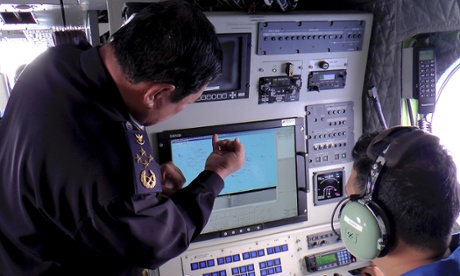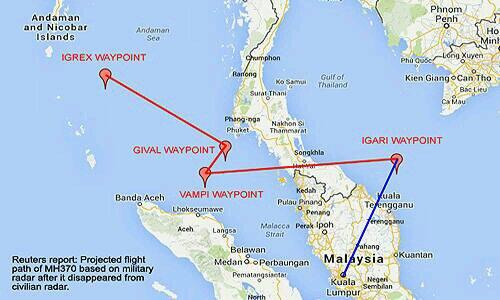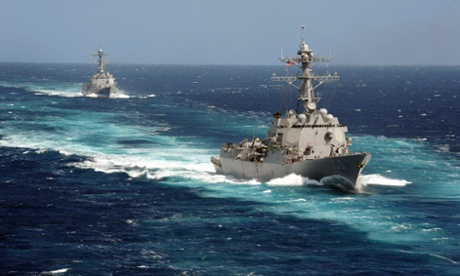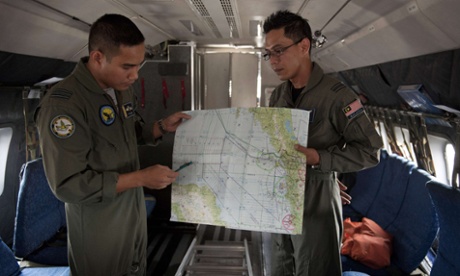بِسْمِ اللَّهِ الرَّحْمَنِ الرَّحِيمِ , الْحَمْدُ لِلَّهِ رَبِّ الْعَالَمِينَ , الرَّحْمَنِ الرَّحِيمِ , مَالِكِ يَوْمِ الدِّينِ , إِيَّاكَ نَعْبُدُ وَإِيَّاكَ نَسْتَعِينُ , اهْدِنَا الصِّرَاطَ المُسْتَقِيمَ , صِرَاطَ الَّذِينَ أَنْعَمْتَ عَلَيْهِمْ , غَيْرِ المَغْضُوبِ عَلَيْهِمْ وَلاَ الضَّالِّينَ.
Assalamualaikum w.b.t/السَّلاَمُ عَلَيْكُمْ وَرَحْمَةُ اللهِ وَبَرَكَاتُه
MH370: First week of searching produces no tangible clues – live
- Satellite company registered ‘routine, automated signals’
- Focus turns to Indian Ocean and Andaman Sea
- Operation now involves 57 ships 48 aircraft
- What to believe? Clarifying conflicting media reports
- Plane disappearances: a brief history
- Read the latest summary
Opening summary
Welcome to our continuing coverage of the search for the missing Malaysia Airlines plane almost a week after it disappeared over the South China Sea with 239 people on board.
Here’s a summary of the latest developments:
- The US has suggested that the search has been extended to the Indian Ocean after the Pentagon said it was sending a destroyer to the area. The White House said that an unspecified “possible piece of information, or pieces of information, has led to the possibility that a new search area may be opened up over the Indian Ocean”.
- Unnamed US officials continue to be quoted insisting that flight 370 sent out automatic status transmissions for hours after the plane lost contact with ground control. The Malaysian authorities say such claims are inaccurate.
- The Wall Street Journal has issued a clarification to point out that its claim that the plane may have flown on for hours is based on a different signals system from the plane’s Rolls-Royce engines. In a correction to its original story it said: “An earlier version of this article incorrectly said investigators based their suspicions on signals from monitoring systems embedded in the plane’s Rolls-Royce PLC engines and described that process.”
- Vietnam has “downgraded but not stopped” its search effort for the plane. A Vietnamese spokesman, Lt Col Nguyen Ngoc Son, said the status of the hunt had been switched from “emergency to regular”.
Updated
Malaysia 'following all leads'
The Malaysian authorities now appear to have a more open mind to reports that the plane sent out signals hours after it lost contact with air traffic control. In yesterday’s press conference they tersely dismissed such reports as “inaccurate”. But now the ministry of transport has tempered that stance.
In its latest statement it said:
Regarding overnight reports in the US media, quoting unnamed US officials:
The investigation team is following all leads that may help locate the missing aircraft. We continue to work closely with the US team, whose officials have been on the ground in Kuala Lumpur to help with the investigation since Sunday.
As is standard procedure, the investigation team will not publicly release information until it has been properly verified and corroborated.
The statement also confirmed that the Indian air force was participating in the search, and that Vietnam was still involved.
And the ministry released a statement from the Chinese embassy confirming that satellite images from Sunday of possible ”debris” from the plane were released in error. No trace of the plane was found at the site. The embassy said:
The publication of the satellite image is an accident – a personal behaviour to put it on the website of SASTIND. The government neither authorised nor endorsed the behaviour which is now under investigation. The image is not been confirmed as connected with the plane.
Updated
Bomohs
In its statements Malaysia’s transport ministry also insisted the government had nothing to do with “bomohs” or shamans at Kuala Lumpur airport who have prompted much interest on social media. The bomohs have been performing rituals at the airport to help find the plane.

Updated
Radar shows plane flew west
Reuters has an intriguing new story which might explain why the search is currently focusing on the Indian Ocean. It says radar suggests the plane was deliberately flown west after losing contact with air traffic control. Under an exclusive tag, it says:
Military radar-tracking evidence suggests a Malaysia Airlines jetliner missing for nearly a week was deliberately flown across the Malay peninsula towards the Andaman Islands, sources familiar with the investigation told Reuters.Two sources said an unidentified aircraft that investigators believe was flight MH370 was following a route between navigational waypoints – indicating it was being flown by someone with aviation training – when it was last plotted on military radar off the country’s north-west coast.The last plot on the military radar’s tracking suggested the plane was flying towards India’s Andaman Islands, a chain of isles between the Andaman Sea and the Bay of Bengal, they said.Waypoints are geographic locations, worked out by calculating longitude and latitude, that help pilots navigate along established air corridors.A third source familiar with the investigation said inquiries were focusing increasingly on the theory that someone who knew how to fly a plane deliberately diverted the flight, with 239 people on board, hundreds of miles off its intended course from Kuala Lumpur to Beijing.“What we can say is we are looking at sabotage, with hijack still on the cards,” said that source, a senior Malaysian police official.All three sources declined to be identified because they were not authorised to speak to the media and due to the sensitivity of the investigation.Officials at Malaysia’s ministry of transport, the official point of contact for information on the investigation, did not return calls seeking comment.Malaysian police have previously said they are investigating whether any passengers or crew had personal or psychological problems that might shed light on the mystery, along with the possibility of a hijacking, sabotage or mechanical failure.The comments by the three sources are the first clear indication that foul play is the main focus of official suspicions in the Boeing 777’s disappearance.As a result of the new evidence, the sources said, multinational search efforts were being stepped up in the Andaman Sea and also the Indian Ocean …The fact that the aircraft – if it was MH370 – had lost contact with air traffic control and was invisible to civilian radar suggested someone on board had turned its communication systems off, the first two sources said.They also gave new details on the direction in which the unidentified aircraft was heading – following aviation corridors identified on maps used by pilots as N571 and P628. These routes are taken by commercial planes flying from south-east Asia to the Middle East or Europe and can be found in public documents issued by regional aviation authorities.In a far more detailed description of the military radar plotting than has been publicly revealed, the first two sources said the last confirmed position of MH370 was at 35,000 feet about 90 miles (144km) off the east coast of Malaysia, heading towards Vietnam, near a navigational waypoint called Igari. The time was 1.21am.The military track suggests it then turned sharply westwards, heading towards a waypoint called Vampi, north-east of Indonesia’s Aceh province and a navigational point used for planes following route N571 to the Middle East.From there, the plot indicates the plane flew towards a waypoint called Gival, south of the Thai island of Phuket, and was last plotted heading north-west towards another waypoint called Igrex, on route P628 that would take it over the Andaman Islands and which carriers use to fly towards Europe.The time was then 2.15am. That is the same time given by the air force chief on Wednesday, who gave no information on that plane’s possible direction.The sources said Malaysia was requesting raw radar data from its neighbours Thailand, Indonesia and India, which has a naval base in the Andaman Islands.

Updated
Malaysia’s defence and acting transport minister Hishammuddin Hussein has confirmed that the search has been extended into the Indian Ocean.
Speaking at a press conference he reiterated that the missing aircraft’s engines did not send out signals after it lost contact with air traffic control.
Updated
On the possible turn back, Hishammuddin repeated that this was still only a “possibility”. He said: “That has not changed.”
Updated
Hishammuddin again said the investigators could not rule out hijacking. All possibilities are being examined, he repeated.
Updated
Updated
Hishammuddin insisted conflicting information about the missing plane was coming from external speculation, not the Malaysian government.
Updated
Hishammuddin has not ruled out raiding homes of crew members of the missing plane. “If investigation requires searching the pilots’ homes, it will be done,” the acting transport minister said.
Updated
The press conference has come to an end. Once again the Malaysian authorities offered little new information about the search for the plane and no breakthrough.
But today the acting transport minister appeared more open minded to new theories, in particular the suggestion that the plane may have been heading for the Indian Ocean.
Updated
Full text of press statement
We are now entering the seventh day of the search for MH370. There are currently 57 ships and 48 aircraft in the search. Thirteen countries are now involved.
Our priority remains finding the plane. We are following all leads, and we continue to work closely with our international partners. We are grateful for the support of our friends and neighbours, who continue to assist us by sharing their data and their resources as we search for MH370. I speak for the Malaysian people when I say that our hearts are with the families and the friends of those on board the plane.New information
There has been a lot of media speculation today after comments from unnamed US officials suggested the plane may have travelled for some time after losing contact.As is standard procedure, the investigation team will not publicly release information until it has been properly verified and corroborated with the relevant authorities. Nor do we want to be drawn into specific remarks that unnamed officials have reportedly made to the media.
Since Sunday, we have worked closely with our international partners, including the US team, whose officials have been here on the ground in Kuala Lumpur.
Since Wednesday, the Malaysian investigating team have shared more detailed information, as it became available, for verification.The international team are currently working on verifying that detailed information, but we have nothing to confirm at the moment.Widening of the investigation
The aircraft is still missing, and the search area is expanding. Two days ago, the search area was widened to include the Andaman Sea.
Together with our international partners, we are now pushing further east into the South China Sea, and further into the Indian Ocean.
We want nothing more than to find the plane as quickly as possible. But the circumstances have forced us to widen our search.
A normal investigation becomes narrower with time, as new information focuses the search. But this is not a normal investigation. In this case, the information we have forces us to look further and further afield.Engine data
Yesterday, we rejected a media report in which unnamed officials said that engine data showed the plane had kept flying for hours after last contact. We checked with Boeing and Rolls-Royce, who said the reports were not true. Today Rolls Royce released a statement saying, and I quote, ‘Rolls-Royce continues to provide its full support to the authorities and Malaysia Airlines. Rolls-Royce concurs with the statement made on Thursday 13 March by Malaysia’s transport minister regarding engine health monitoring data received from the aircraft.’Oil slick
Yesterday authorities sighted two oil slicks in the South China Sea, 60 nautical miles south of the last point of contact with MH370.
The first slick was investigated and analysed and found to contain tiny traces of jet fuel. No debris was found in the vicinity. We do not believe the slick is linked to MH370.Samples from the second slick were investigated and analysed and did not contain jet fuel.Concluding remarks
The investigation team is following all leads that could help locate the missing aircraft. When we receive new information, and it has been verified, we act accordingly. Wherever there is a possibility, we have a duty to investigate it.
From the beginning of the crisis, we have worked hand-in-hand with all the relevant authorities, including international agencies, experts, and the aircraft manufacturers.
We have daily technical meetings with all the key players. We have followed the protocols set out by the International Civil Aviation Authority. We have been in regular contact with our neighbouring countries. And we have welcomed all international offers of assistance. We are committed to one aim: finding MH370.
Updated
Rolls-Royce
As Hishammuddin mentioned, Rolls-Royce has issued a statement denying that its engines sent out signals from the missing aircraft after it vanished from air traffic control screens.
The statement, which was also sent to the Guardian, said:
Rolls-Royce continues to provide its full support to the authorities and Malaysia Airlines. Rolls-Royce concurs with the statement made on Thursday 13 March by Malaysia’s transport minister, Hishammuddin Hussein, regarding engine health monitoring data received from the aircraft.
During that press conference Hishammuddin quoted Rolls-Royce saying that a report in the Wall Street Journal claiming the plane had sent signals hours after it lost contact with air traffic control were inaccurate. The WSJ has since published a correction saying the signals came from a separate communication device from the engines.
In a preamble to its statement Rolls-Royce also said:
We are treating this as if it were already a formal investigation and that means we are unable to share the information with you that we have shared with the authorities in Malaysia as it must be treated as confidential. It also means that we needed to ensure that the authorities were aware before we made any statement.

Updated
UK experts due in Malayia
The civil aviation chief Azharuddin Abdul Rahman told the press conference aviation experts from the UK, including from Rolls-Royce, were due to arrive in Malaysia to help in the investigation. “They indicated that they are studying the possibility of satellite communication, and will share it with us,” he said.
Updated
Singapore Today has retweeted a map plotting the possible flight path as detailed by military radar cited by Reuters sources.
In their press conference the Malaysian authorities stressed that this possible data was not confirmed. Hishammuddin said: “If we can confirm that is actually MH370, then we can move all our assets from the South China Sea to the strait of Malacca. At the moment I’m not in a position to do that.” 

Data sharing
Malaysia now appears to have access to military data from other countries, particularly the US, which might help explain why the authorities now seem more open to reports that the missing plane was detected hours after it lost contact with air traffic control.
The Wall Street Journal claims the search is now focused hundreds of miles west from its original flight path based on “pings” picked up by satellite.
New data from other countries is being “digested”, Hishammuddin Hussein confirmed. He added that he hoped to have more confirmation of the data over the next couple of days.
The WSJ reported:
The satellites also received speed and altitude information about the plane from its intermittent “pings,” the people said. The final ping was sent from over water, at what one of these people called a normal cruising altitude. They added that it was unclear why the pings stopped. One of the people, an industry official, said it was possible that the system sending them had been disabled by someone on board.The people, who included a military official, the industry official and others, declined to say what specific path the transmissions revealed. But the U.S. planned to move surveillance planes into an area of the Indian Ocean 1,000 miles or more west of the Malay peninsula where the plane took off, said Cmdr. William Marks, the spokesman for the US Seventh Fleet.
Updated
Transponder
Hishammuddin confirmed that the investigators are examining the possibility that the plane’s transponder was deliberately shut down.
Asked about the transponder he said: “There are four or five possibilities which we are exploring. It could have been done intentionally, it could be done under duress, it could have been done because of an explosion. That’s why I don’t want to go into the realm of speculation. We are looking at the all the possibilities.”
He confirmed that crew were being investigated.
Updated
Summary
Here’s a roundup on the latest on the search operation for the missing plane.
- The Malaysian authorities have indicated they are open minded to reports which cite US officials, suggesting the missing plane change course and headed west. The acting transport minister Hishammuddin Hussein confirmed that the search has extended into the Indian Ocean.
- Radar and satellite information from other countries, including the US, is now being shared with Malaysia. This is currently being “digested,” Hussein said.
- Military radar-tracking evidence suggests the plane was deliberately flown across the Malay peninsula towards the Andaman Islands, according to Reuters. Its sources said the plane appeared to have flown between navigational waypoints west of Malaysia indicating it was being flown by someone with aviation training.
- Rolls-Royce has issued a statement denying that its engines sent out signals from the missing aircraft after it vanished from air traffic control screens. A team of experts from the UK, including staff from Rolls-Royce is due to arrive in Malaysia to help with the investigation.
- The Wall Street Journal claims the search is now focused hundreds of miles west from the plane’s original flight path based on “pings” picked up by satellite. The White House said that an unspecified “possible piece of information, or pieces of information, has led to the possibility that a new search area may be opened up over the Indian Ocean”.
- There has been no confirmed sighting of debris from MH370 almost a week after it disappeared with 239 passengers on board. The search operation now involves 57 ships, 48 aircraft, and 13 countries.
The Chinese are joining the westward focus of the search. The marine patrol ship Haixun 31 is heading for the Strait of Malacca, according to the state news agency Xinhua. 

The French aviation site Air Info has a more detailed map of the missing plane possible flight path based on that Reuters story. 

The USS Kidd is en route to the western tip of the Strait of Malacca to aid the search at the request of the Malaysian government, writes the Guardian’s US security editor Spencer Ackerman.
It left from the Gulf of Thailand yesterday and the Navy expects it will be in the Strait by Saturday, according to navy spokeswoman Lauryn Dempsey.Additionally, a P8 Poseidon surveillance plane is also on its way to the area, flying from Kadena Air Force Base in Japan.These are the only planned US military assets aiding the search at the moment. The USS Pinckney, which was in the Gulf of Thailand to aid the search,
has now returned to the Strait of Singapore for pre-planned maintenance.

Indian aircraft have searched over the Andaman and Nicobar Islands, after suggestions that the missing plane last headed towards the heavily forested archipelago, according to Reuters.
Popular with tourists and anthropologists alike, the islands form India’s most isolated state. They are best known for dense rainforests, coral reefs and hunter-gatherer tribes who have long resisted contact with outsiders.
Two sources told Reuters the unidentified aircraft appeared to be following a commonly used navigational route that would take it over the islands.
The Indian Navy has deployed two Dornier planes to fly across the island chain, a total area of 720 km (447 miles) by 52 km), Indian military spokesman Harmeet Singh said in the state capital, Port Blair. So far the planes, and a helicopter searching the coast, had found nothing.
“This operation is like finding a needle in a haystack,” said Singh, who is the spokesman for joint air force, navy and army command in the Andaman and Nicobar islands.
The Defence Ministry said the Eastern Naval Command would also search across a new area measuring 15 km by 600 km along the Chennai coast in the Bay of Bengal.
The shape of this area, located 900 km west of Port Blair, suggested the search was focusing on a narrow flight corridor.

Some 2.3 million internet users have joined the search for the plane by scanning the Tomnod website and its access to satellite imagery, writes Carmen Fishwick.
Tomnod is run by commercial satellite company DigitalGlobe, which soon after the plane’s disappearance repositioned two of its five satellites over its last known location in the Gulf of Thailand, and have since moved them as the search headed west.Tomnod users are provided with a randomly chosen map from the search area and are told to drop a pin if they see signs of aeroplane wreckage, life rafts, oil slicks or anything that looks “suspicious”.An algorithm then finds where there is overlap in tags from people who tagged the same location, and the most notable areas are shared with authorities. A Tomnod spokesperson said that as of Thursday every pixel had been looked at by human eyes at least 30 times.Despite the huge online search party, the Tomnod hunt has so far have proved inconclusive. But that – and the fact crowdsourcing was disastrously discredited during the hunt for the Boston bombers and the search for adventurer Steve Fossett’s single-engine plane – hasn’t stopped millions of people searching the maps and tagging over 745,000 images they believe may be signs of the missing Malaysian Airlines plane.
Malaysia’s prime minister Mohd Najib Tun Razak has prayed for the passengers and crew at a mosque near Kuala Lumpur airport. He has also had another briefing on the expanding search operation for the plane.
In a Facebook update he paid tribute to the tireless efforts of those involved in the operation.

India’s navy says it has nearly doubled the number of ships and planes deployed to search the Andaman Sea, according to AFP.
It said six ships and five aircraft were now scouring for any sign of the vanished plane in the Andaman Sea, which surrounds India’s remote Andaman and Nicobar group of islands.“We want to cover the area and it should be strictly done,” Indian naval spokesman DK Sharma told AFP.India had earlier deployed three ships and three aircraft in the search.The Indian ships and aircraft were looking in an area “designated” by the Malaysian navy in the southern region of the Andaman Sea, Sharma said.

Satellite company says it registered signals
Inmarsat, the £3bn satellite company, registered “routine, automated signals” from MH370 on its network, the company said in a brief statement on its website.
The statement does not mention for how long the signals were received or when they stopped.
Here’s the statement in full:
14 March 2014: Inmarsat has issued the following statement regarding Malaysia Airlines flight MH370.Routine, automated signals were registered on the Inmarsat network from Malaysia Airlines flight MH370 during its flight from Kuala Lumpur.This information was provided to our partner SITA, which in turn has shared it with Malaysia Airlines.For further information, please contact Malaysia Airlines.
“Such signals are very reliable,” but would not indicate location, an Inmarsat executive told NPR’s Frank Langfitt:
David Coiley, vice president of aviation at Inmarsat, declined in an interview to discuss the specifics of the Malaysia Airlines case. But he said that in general, such signals are very reliable. ‘I‘d say way over 99 percent. It’s highly unusual to get a false positive that the system was still operating when in fact it wasn’t,’ he said.” [...]Coiley, the Inmarsat executive, told Frank that the pings received by its satellites would not include data on altitude or a plane’s position.
Updated
The MH370 pilots were “a middle-aged family man passionate enough about flying to build his own simulator and a 27-year-old contemplating marriage who had just graduated to the cockpit of the Boeing 777,” the Associated Press reports:
Police have said they are looking at the psychological background of the pilots, their family life and connections as one line of inquiry into flight MH370’s disappearance, but there is no evidence linking them to any wrongdoing.
The plane was flown by Zaharie Ahmad Shah, 53, and Fariq Abdul Hamid, 27, who was featured in recent a CNN report:
Fariq, the son of a high-ranking civil servant in Selangor state, joined Malaysia Airlines in 2007. With just 2,763 hours of flight experience he had only recently started co-piloting the sophisticated Boeing 777.He had a short brush with fame when he was filmed recently by a crew from “CNN Business Traveler.” Reporter Richard Quest called it a perfect landing of a Boeing 777-200, the same model as the twin-aisle plane that went missing. An online tribute page to the pilots shows a photo of Fariq in the cockpit with Quest, both smiling.Neighbor Ayop Jantan said he had heard that Fariq was engaged and planning his wedding. The eldest of five children, his professional achievements were a source of pride for his father, said Ayop, a retiree.Fariq’s superior, Zaharie, joined Malaysia Airlines in 1981 and has more than 18,000 flight hours.
Read the full piece here.
Updated
Summary
• The search for MH370 grew on the Indian Ocean side of Malaysia as military radar readings and satellite readings appeared to suggest the plane flew west for hours. India began conducting overflights with heat sensors of the remote Andaman Sea islands.
• A satellite company said its network registered “routine, automated” signals from the flight. The Guardian is seeking confirmation of reports that the signals lasted hours.
• Two unnamed sources close to the investigation told Reutersthat radar showed an unidentified aircraft believed to be MH370 following a route between navigational waypoints in the direction of theAndaman Islands. Malaysia requested additional raw radar data from its neighbors.
• Malaysian officials acknowledged speculation that the plane flew for hours after losing contact and said teams were “working on verifying that detailed information.”
• There has been no confirmed sighting of debris from MH370 a week after it disappeared with 239 passengers on board. The search operation now involves 57 ships, 48 aircraft, and 13 countries.
Updated
The Associated Press quotes an unnamed US official as saying the MH370 transponder stopped “about a dozen minutes before a messaging system on the jet quit.” The official calls it “key evidence for[possible] human intervention,” AP reports.
It wasn’t clear what “messaging system” the report referred to, however. An unnamed senior Obama administration official was quoted Thursdayas saying that the plane continued to send out some Aircraft Communications and Reporting System (ACARS) data for hours after it lost contact with ground control, and a satellite company said its network had registered “routine, automated signals” from the plane.
In other timelines, the loss of ACARS has been placed before the loss of the transponder. Malaysia Airlines chief executive Ahmad Jauhari Yahyasaid early Thursday that the last (ACARS) data were sent at 1:07 a.m., 14 minutes before the transponder signal was lost. Malaysian officials’ statements have proven inconsistent.
Guardian transport correspondent Gwyn Topham (@GwynTopham) has confirmed with the satellite company Inmarsat that its network registered“routine automated signals” from MH370.
“The signals, described as a series of ‘pings’ to the satellite, indicated that its communication system was still working, but not transmitting data,” Gwyn writes, and “such pings are only received when the normal data transmission is not operating, once per hour. The information would support theories that the plane’s system was deliberately switched off”:
David Coiley, vice president, aviation, at Inmarsat, said: “When the system is not transmitting or receiving data on the aircraft, it will send network signalling info to establish that the aircraft satellite communication is switched on, to say that the system could communicate. If we haven’t seen any activity from an aircraft or ship it’s a check. It’s a simple acknowledgement.“The ping doesn’t say anything other than that the satellite communications is functioning.”Coiley said an analogy was signalling that mobile phones use that is noticeable as interference (eg near radios) even when not in use, as they establish contact with networks.Such signals would not transmit location but can indicate a position and distance relative to the satellite which could give a guide to a rough direction of travel over several hours.The Inmarsat system is installed in over 90% of long haul passenger planes worldwide.
Coiley told Gwyn that any total absence of communication during normal aviation would be “a highly unusual situation. The systems are designed to allow people to communicate when they want to communicate, constantly.”
Updated
Some theorists of the fate of MH370 have picked up on a South China Morning Post story from Friday that suggests an 8 March seismic event on the sea floor between Vietnam and Malaysia may have been tied somehow to the plane’s demise.
The SCMP includes what it says is a statement by Chinese seismologists explaining that “It was a non-seismic zone, therefore judging from the time and location of the event, it might be related to the missing MH370 flight.”
Not hardly true, according to US Geological Survey scientists. “The location coincides with a region of regularly occurring seismicity along the Sunda-Java trench,” the USGS said in a report quoted by NBC News.
“The bump from the plane hitting bottom of the ocean would not be noticeable,” earthquake expert John Vidale of the University of Washington told USA Today.
The location — southwest of Sumatra — is also prone to volcanoes,the USGS added.
Updated
US ships are moving into the Indian Ocean to undertake a search “due west” of Kuala Lumpur, US Navy Commander William Marks of theUS 7th Fleet has just told CNN from aboard the USS Blue Ridge Command Ship, positioned “a little northwest of the Malacca Strait” at 5am local time.
“As you look west, and you transition west to the Indian Ocean, ships alone are really not quite much of a solution, because of the expanse of the ocean,” Marks told CNN. “You have to look at what other assets you have.”
Marks said the navy was using helicopters and surveillance aircraft to look for MH370. “We’re looking essentially west of Kuala Lumpur ... due west,” he said.
A P8 Poseidon aircraft has reached the Bay of Bengal and is patrolling for debris, the Navy told the Guardian, and the USS Kidd destroyer also is in the area, Marks said, adding that the search party now includes 57 ships and 40-some aircraft from 13 countries.
“We just have to take it little by little,” Marks said. “That’s the best we can do out here.”
Updated
Malaysia Airlines flight 370 made significant changes in altitude and took more than one turn after losing contact with ground control, in a pattern that suggests someone was flying it, the New York Times reports, quoting “American officials and others familiar with the investigation”:
Radar signals recorded by the Malaysian military appear to show the missing airliner climbing to 45,000 feet, above the approved altitude limit for a Boeing 777-200, soon after it disappeared from civilian radar and made a sharp turn to the west, according to a preliminary assessment by a person familiar with the data.The radar track, which the Malaysian government has not released but says it has provided to the United States and China, then shows the plane descending unevenly to an altitude of 23,000 feet, below normal cruising levels, as it approached the densely populated island of Penang, one of the country’s largest. There, the plane turned from a southwest-bound course, climbed to a higher altitude and flew northwest over the Strait of Malacca toward the Indian Ocean.
The Times story cautions that data from engines and radar is “incomplete and difficult to interpret.” Read the full piece here.
Updated
Summary
We’re going to wrap up our live blog coverage for the day. Here’s a summary of where things stand:
• No tangible clue to the fate of Malaysia Airlines flight 370 had emerged after a week of searching. The plane disappeared north of Kuala Lumpur in the early hours of 8 March with 239 people aboard.
• US ships, helicopters and surveillance aircraft expanded a search on the Indian Ocean side of Malaysia. India sent flights with heat sensors over the remote Andaman Sea islands. “We just have to take it little by little,” a US Navy commander said.
• Flight 370 made significant changes in altitude and took more than one turn after losing contact with ground control, in a pattern that suggests someone was flying it, the New York Times reported, quoting “American officials and others familiar with the investigation.”
• The Indian Ocean search intensified, an Obama administration official said Thursday, based on radar readings and automated transmissions from the plane that registered on a satellite network.
• A satellite company said its network had picked up “routine, automated signals” from the plane, but executives would not say for how long. Such pings are only received when the normal data transmission is not operating, once per hour, the company, Inmarsat, told the Guardian.
Sumber: ((http://www.theguardian.com))
Blogger Home.
s3v3n
s3v3n
copyright©



Tiada ulasan:
Catat Ulasan